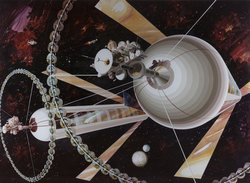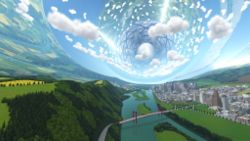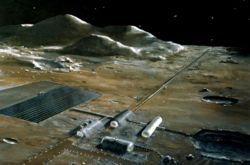Difference between revisions of "Space habitats"
m |
(→Places) |
||
| Line 36: | Line 36: | ||
==Places== | ==Places== | ||
| − | ===Low Earth orbit=== | + | ====Low Earth orbit==== |
The easiest place to get to from Earth is '''low earth orbit''', although due to the Earth's strong gravitational pull it requires enormous amounts of energy to bring material up from the surface and one could not be classed as self-sufficient here, however the views are pretty good. If we develop more efficient means of [[Colonising Space/Access to space|access to space]] than we currently have, low Earth orbit habitats become more feasible. | The easiest place to get to from Earth is '''low earth orbit''', although due to the Earth's strong gravitational pull it requires enormous amounts of energy to bring material up from the surface and one could not be classed as self-sufficient here, however the views are pretty good. If we develop more efficient means of [[Colonising Space/Access to space|access to space]] than we currently have, low Earth orbit habitats become more feasible. | ||
| − | ===Geosynchronous orbit=== | + | ====Geosynchronous orbit==== |
In a {{wp|Geosynchronous_orbit|geosynchronous orbit}} the habitat would hover the same spot on Earth which would mean that one would have the same day / night cycle as on the surface which is an important consideration with human physiology. | In a {{wp|Geosynchronous_orbit|geosynchronous orbit}} the habitat would hover the same spot on Earth which would mean that one would have the same day / night cycle as on the surface which is an important consideration with human physiology. | ||
| − | ===Lunar orbit=== | + | ====Lunar orbit==== |
In '''lunar orbit''' the moon is within easy reach but the habitat will be subject to the moons two-week long day / night cycles which might not be to everyone's taste, although of course the normal light rhythms can be replicated internally with lighting. | In '''lunar orbit''' the moon is within easy reach but the habitat will be subject to the moons two-week long day / night cycles which might not be to everyone's taste, although of course the normal light rhythms can be replicated internally with lighting. | ||
| − | ===Surface of the moon=== | + | ===Moons and planets=== |
| + | ====Surface of the moon==== | ||
The '''surface of the moon''' provides a continent-sized area to inhabit and somewhere to 'get outside'. However it is not clear that the one-sixth of Earth's gravity here is enough to stop degredation of the human body over extended periods, but this could be overcome by having large circular habitats that rotate to simulate a 1g environment. | The '''surface of the moon''' provides a continent-sized area to inhabit and somewhere to 'get outside'. However it is not clear that the one-sixth of Earth's gravity here is enough to stop degredation of the human body over extended periods, but this could be overcome by having large circular habitats that rotate to simulate a 1g environment. | ||
| − | ===Surface of Mars=== | + | ====Surface of Mars==== |
Terraforming refers to re-engineering the environment of a planet to make it more like Earth, that is, more friendly to life. To terraform Mars we need three things: heat, oxygen and water. Ironically, the very scientific knowledge gained by studying the destruction of the Earth's biosphere can be applied to engineering a new biosphere on Mars; releasing enough CFCs or similar greenhouse gases into the atmosphere should create enough global warming to make the planet amenable to human life. There is [http://antwrp.gsfc.nasa.gov/apod/ap040904.html plenty of water] frozen below the surface, which should melt if the temperature is raised enough. Oxygen could be supplied by culturing bacteria that can release it from metallic oxides, or by using [[advanced automation]] to build large-scale plants to release the oxygen using industrial processes. | Terraforming refers to re-engineering the environment of a planet to make it more like Earth, that is, more friendly to life. To terraform Mars we need three things: heat, oxygen and water. Ironically, the very scientific knowledge gained by studying the destruction of the Earth's biosphere can be applied to engineering a new biosphere on Mars; releasing enough CFCs or similar greenhouse gases into the atmosphere should create enough global warming to make the planet amenable to human life. There is [http://antwrp.gsfc.nasa.gov/apod/ap040904.html plenty of water] frozen below the surface, which should melt if the temperature is raised enough. Oxygen could be supplied by culturing bacteria that can release it from metallic oxides, or by using [[advanced automation]] to build large-scale plants to release the oxygen using industrial processes. | ||
| Line 55: | Line 56: | ||
* [http://www.users.globalnet.co.uk/~mfogg/paper1.htm Further info on terraforming by Martyn Fogg] (an appropriate name for someone who is an expert in terraforming...) | * [http://www.users.globalnet.co.uk/~mfogg/paper1.htm Further info on terraforming by Martyn Fogg] (an appropriate name for someone who is an expert in terraforming...) | ||
| − | = | + | ====Venus atmosphere==== |
| − | + | ||
| − | + | ||
| − | + | ||
| − | + | ||
| − | + | ||
| − | + | ||
| − | + | ||
| − | + | ||
| − | + | ||
| − | + | ||
| − | ===Venus atmosphere=== | + | |
There are formidable obstacles to establishing human life on the surface of Venus: the surface temperature is around 450°C and the pressure is around 90 atmospheres {{en}} equivalent to the pressure at around one kilometre under Earth's oceans. However, 50km above the surface of the planet we find Earthlike temperatures and pressures. It has therefore been proposed that the easiest way to establish a colony on Venus would be to fill a gigantic balloon with breathable air. Such a structure would float above the denser air of Venus in the same way that a helium balloon floats above Earth. | There are formidable obstacles to establishing human life on the surface of Venus: the surface temperature is around 450°C and the pressure is around 90 atmospheres {{en}} equivalent to the pressure at around one kilometre under Earth's oceans. However, 50km above the surface of the planet we find Earthlike temperatures and pressures. It has therefore been proposed that the easiest way to establish a colony on Venus would be to fill a gigantic balloon with breathable air. Such a structure would float above the denser air of Venus in the same way that a helium balloon floats above Earth. | ||
| Line 76: | Line 66: | ||
*[http://spacemonitor.blogspot.com/2007/05/copy-of-pdf-file.html Geoffrey A. Landis' original proposal for such a habitat] | *[http://spacemonitor.blogspot.com/2007/05/copy-of-pdf-file.html Geoffrey A. Landis' original proposal for such a habitat] | ||
| − | ===Venus surface=== | + | ====Venus surface==== |
*http://www.terraformers.org.au/start.html | *http://www.terraformers.org.au/start.html | ||
| − | === | + | ====Mars orbit==== |
| − | == | + | |
| − | + | ||
| − | ===Other moons=== | + | ====Other moons==== |
Many to choose from. | Many to choose from. | ||
| Line 89: | Line 77: | ||
Europa around Jupiter has lots of H<sub>2</sub>O and O<sub>2</sub>. Underneath the ice are liquid oceans which may harbour life. | Europa around Jupiter has lots of H<sub>2</sub>O and O<sub>2</sub>. Underneath the ice are liquid oceans which may harbour life. | ||
| + | |||
| + | |||
| + | ===Dyson swarm=== | ||
| + | A Dyson swarm refers to a series of habitats build in space around the Sun. These habitats would be artificial space stations like a {{wp|Stanford_torus|Stanford torus}}, rather than being built on naturally-occuring celestial bodies. The technology to build these has been around for decades, as they require nothing more than industrial manufacture of large metallic structures, similar to what is used to build supertankers on Earth. | ||
| + | |||
| + | The first step to building such habitats would be to set up automated facilities on the moon to mine titantium and iron and launch it into space. A habitat could then be assembled in space, and used to manufacture another habitat, making them self-replicating. Using materials from the moon and asteroid belt alone, we could create artificial habitats with thousands of times the land area of Earth, able to comfortably accomodate tens of trillions of people. | ||
| + | |||
| + | ====Lagrangian points==== | ||
| + | |||
| + | ====Solar orbit==== | ||
| + | |||
| + | |||
| + | ====Asteroid Belt==== | ||
| + | =====Ceres===== | ||
| + | (Water ice) | ||
== Various types of habitat == | == Various types of habitat == | ||
Revision as of 12:28, 23 September 2010
|








